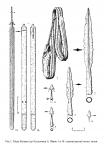Summary (English)
In the summer of 2010 the investigation the hillfort and the burial moundin the eastern part of the Mala Kopanya village continued. The south – east part of the settlement was excavated over an area of 141 m2.The depthof the occupation layer was 1, 8 m. There were two layers. The upper layer, brown, was nearly 0,6 mdeep. The bottom layer, taupe, was of humic consistency. 11 postholes were discovered. In squares Е-Ж-6-7, at 0,8–0,9 m depth was a deposit of clay. There were a lot of individual finds, in two clusters, separated by 10m… There were 4 hand-made pots and sherds of decorated and gray-polished pottery below the clay.
Among the tools recovered were a chisel, querns, spindle whorls andknives. Among the weapons were four pikes and a dart. Among the jewelry and clothing accessories were various bronze objects : 8 fibulas, belt pendants and fragments of bracelets. Judging by the fibulas and dippers this part of site dates to first decades of the 1st cent. AD.
In the upper layer a rectangular building was investigated. There was pottery of the10th–11thcent. AD.The investigation of the burial mound at the tract Chellenytsya (natural boundary) was also continued over an area of 1448 m2. There were two cremations (19 –20) in pits 0, 5 and 0, 2 m in diameter and 0,25 and 0,15 m in depth. A lot of the finds were found outside the burials. There were weapons, ridingequipment, harness elements jewelry and clothing accessories.
Among the weapons were a ritually-bent sword, spears, dart points and arrows. Among the defensive weapons were fragments of umbos. The clothing ornaments were represented by 28 iron fibulae, bronze belt ornaments, buckles, pendants and bracelets. There was also a unique find, an iron pyxis with glass beads, which was burned. This investigation helps to relate items of the tract Chellenytsya (natural boundary) to the Dacian antiquities of the first half of the 1th cent. AD.






![Download [PDF]](/excavation/skins/fasti/images/results/download_sml.png)